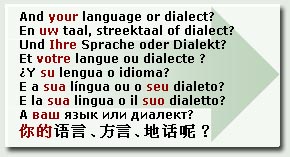Daź kuninglīhhīn
 Daź kuninglīhhīn habēta sīn nëst in demo wagankubisine. Eines wārun die eltirōn
beide ūźgiflogan. Sie woltan furi iro fugililīn eddeswaź zi ëźźan gihalōn
inti habēnt die smalfogalā in demo nëste alles ein gilāźan.
Daź kuninglīhhīn habēta sīn nëst in demo wagankubisine. Eines wārun die eltirōn
beide ūźgiflogan. Sie woltan furi iro fugililīn eddeswaź zi ëźźan gihalōn
inti habēnt die smalfogalā in demo nëste alles ein gilāźan.
Bī dëru wīlu quam dër fater widar heimo.
»Waź ist dār wortan?« quad ër, »Wër habēta iu wih gileidigōt, kindilīn,
daź ir sō irflougit sīt?«
»Ah, fater,« quadun sie, »dār quam midunt einiu mihhillīhiu talamaska
firgifaran. Harto ginōto grimlīh inti bruttilīh was ira gihabida! Siu stārita
in unsaź nëst mit irēn mihhillīhēn ougōn. Bīdiu birun wir nū sō irbruttit.«
»Aha!« quad dër fater, »Warot ist siu nū gifaran?«
»Nū,« quadun sie, »siu ist dara after hinān gifaran.«
»Bītet!” quad dër fater, »Ih willu iru gifolgēn. Bilinnat, kindilīn!
Ni kurīt forhten mēr. Ih scal sia wola fāhan.« Sān floug ër demo bōsiwihte
ouh nāh.
Sāsō ër umbi dea ekka quam sah ër dara einen lëo. Dër giang dara umbi.
Doh daź kuninglīhhīn forhta nalles. Iź floug nidar ūf dës lëwes ruggi
inti gifiang zi skeltan. »Waź habēst dū bī mīnemo hūse zi suohhen inti mīne
kleine kindilīn zi brutten?«
 Daź merreta dën lëo nalles, inti ër giang in guotemo fram.
Daź merreta dën lëo nalles, inti ër giang in guotemo fram.
Ubar daź ward daź kuoni wīgantlīhhīn dës diu wuotīgōro. »Ni trofen
habēst dū dara zu suohhen! Daź sagōm ih dir. Joh ... quëmēst dū widar,« quad
iź »sō scalt dū eddeswaź irlīdan. Ih willu iź ni wiht lustlīhho tuon,« quad
iź inti mit desiu irhuob eines sīnero fuoźilīn, »doh welle ih dir mit einemo
stapfe dën ruggi brëhhan.«
Daranāh floug iź dana heimo nāh demo nëste.
»Sēnū, kindilīn!« quad iź, »demo habēm ih daź intwonēt. Dër quimit
giwisso niomēr hera.«

